Simply Sunday - Room at the Table
Big round tables, infinite personal galleries of inspiration, Gertrude Stein's salon, panel practice and the search for the right palette, resilience, and more.
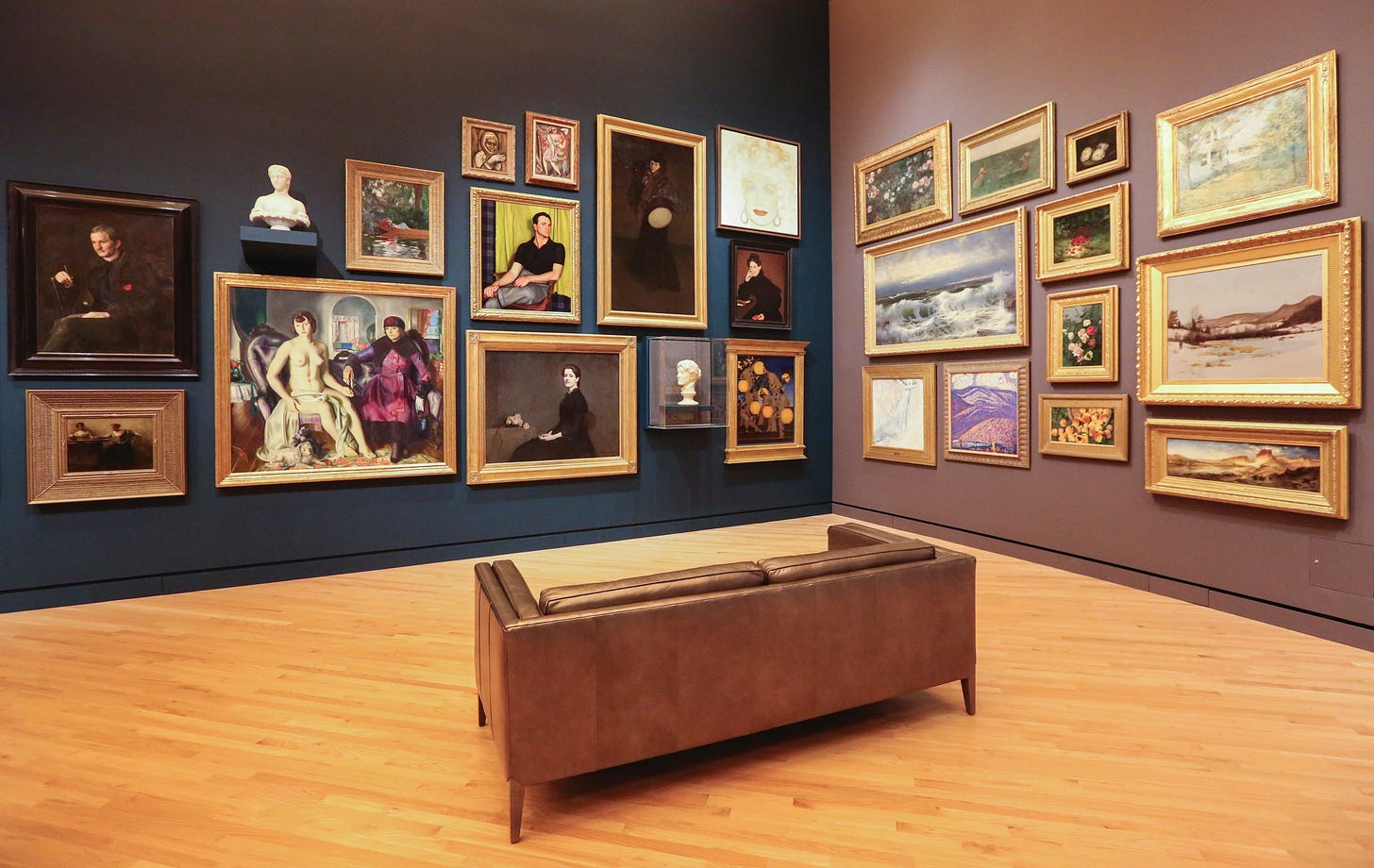
Hello! I hope you've had a good span of days. It feels like the turn of the year is upon us. Light is changing. Schedules are changing. There are goodbyes.
I am finding summer is dragging me down. Sticky like molasses. Slow. Disappointing. Tired. When I got in a quick walk before the pharmacy after work, I noted that the kite from several months ago is still stuck in the tree. It's lost all the shiny pinkness from when I first saw it, but it's still there. And I'm still walking that same little loop, dodging dogs, keeping an eye out for coyotes, eyeing other walkers who walk alone and wondering what it takes to change that, reveling in the strong wind that tends to blow across the loop and through the canyon below, and turning and walking the other way anytime the far end of the loop seems like a risk.
One of the prompts this week is about resilience. When I sat down to make the prompt set image, I couldn't remember exactly why I added that to the mix when I was thinking about prompts for Week 34. It doesn't fit anything obvious.
An "expression of resilience."
So many things come to mind.
Resilience. It's an interesting word. I almost changed it, thinking I should go with something else, like determination. For some reason, resilience felt important, but in hindsight, I think perseverance may have been more what I was after. That would have been along the lines of "stick-with-it-ness" rather than "get-back-up-ness." (Did you know that stick-to-itiveness is a word?)
But resilience. Maybe there was a subconscious reason. I love words as a context for thinking during a week, a bit of gossamer that can be spread over the page, winding in and around other notes and drawings, a lens and a filter.
For those who like to include quotes in their work, here are a few you might enjoy:
“All I could do was what I had done each morning for all these years. Light my lamp. Every Single. Day.” ― Ranjani Rao
“May there always be future dawns.” ― Marie Lu
“Fall seven times, rise eight.” (Nana korobi, ya oki) ― Japanese proverb
“The oak fought the wind and was broken, the willow bent when it must and survived.” ― Robert Jordan
“I can be changed by what happens to me. But I refuse to be reduced by it.” ― Maya Angelou
Do any of these speak to you?
Today's post meanders a bit in a circle about the size of the proverbial table, about making room, about widening circles, about being inspired by lots of people rather than by a select few or, at the very least, making your own choices and being open to reading, looking, appreciating beyond the "best of" lists. (I didn’t bring in Arthur and the “round table” because we would never have found our way home. But I do have a soft spot…)
Thank you for reading.
If you get bored or lost in the first part, there's a small graphic novel sequence at the bottom. I hope you'll take a look. Vulnerable sharing is often the name of the game, but that vulnerability is amplified in silence. That kind of resilience tends to be depressing.
Thank you for making time.
Amy
Room at the Table
One of the things I love about podcasts and self publishing and social media is that these spaces and mediums open up the creative landscape and give more people a voice, an outlet, a place to stake their flag, a beach from which to send up smoke signals, and a place to think out loud, share, wonder, ponder, and be. The map for creativity isn't only found in galleries, best-sellers, and top 10 (or even top 100) lists. Our current spaces highlight that there are thousands and thousands and thousands of talented people out there, people making, marking, and weaving their vision and truth in myriad ways.
There are so many people making awesome art (in whatever medium you want to look at), people who are creating brilliant work on the side or as a hobby or because the process makes a difference in their day. There are so many talented people writing, painting, drawing, and creating. Being able to see and follow and admire and appreciate such a diverse range of work is what keeps me scrolling at Instagram. I am a fan of the "explore" screen. There is always something or someone new that I might never otherwise have seen.
So many people.
This is part of the beauty and the wonder of our time. We may or may not make a fortune or get more than a few likes, but the barriers to putting our art into the world, sharing our vision, and telling our story are relatively low.
There is room.
There is room for every artist, every voice, every unique perspective and whimsical approach. We don't have to all do it the same way.
Why would we not want there to be room?
One of my things on Sunday in our group where we've shared "Sunday coffee" for many years is that there is room at the table. Pull up a chair. We'll scoot over. We'll scoot out and expand the circle. That's what kids do when they sit in a circle and then need to make room for someone... they scooch back a bit to make room. Newcomers are easily enfolded into the undulating shape because there is room.
I always enjoyed the elementary school art fair. The varied work of so many young artists all juxtaposed, side by side on portable walls and tables.
Why would we not want there to be room?
Unless you were at the popular table to begin with, you probably think a table where there is room for everyone seems like a relatively utopian concept. (Of course, we pretty quickly will have qualifiers because there are always going to be ground rules for the table, things we might want to all agree upon. We do have limits and reasons for those limits, but in general, the table can be larger than we think.)
An infinite table though would be unwieldy. We would likely never see or interact with those sitting on the other side.
So many people. That's exciting, but, yes, it can also be overwhelming. There are reasons there are so many people talking about taking breaks from social media or limiting the time they spend scrolling. These moderation steps can be important on an individual basis and can help us make more time for actively creating rather than just scrolling and "thinking" about creating.
But does this mean you need to limit your openness to only a few people as sources of inspiration?
Why would we not want there to be room at the table for voices big and small, for those with art backgrounds or MFAs or degrees or paychecks as well as those working from couches and in the wee hours on this side or that of full-time jobs, caregiving, parenting, school, and busy lives?
If we think not of a table but of our own private gallery, our own inspiration board, our own infinite scroll populated with art and story and text and sound.... the things that inspire us and make us think and make us feel alive and nurture our own creative spirit, we have a space where we can continue to pin up the bits and pieces that speak to us. We wouldn't expect everyone to have exactly the same room, the same mix, the same set of inspiration pieces and voices.
There might be overlaps though, voices that appear and reappear on these endless inspiration boards. We gather these voices through our scrolling, through our sharing, through seeing what our contacts and friends share. Who are they reading? What are they enjoying? What have they discovered? We leapfrog along picking up new influences and inspiration points, and continuing to add to our inspiration boards.
How many artists, writers, and poets can you name from the 19th century? (Who did you study in school? Go on. Make a list.) Can you name 20 writers? Probably some of these writers come to mind:
Mark Twain, George Eliot, Walt Whitman, Edgar Allen Poe, Charles Dickens, Charlotte Bronte, Emily Bronte, Henry James, Jane Austin, Leo Tolstoy, Ralph Waldo Emerson, Mary Shelley, Henry David Thoreau, Nathaniel Hawthorne, Herman Melville, Lewis Carroll, Oscar Wilde, Louisa May Alcott, William Butler Yeats, Emily Dickinson, Elizabeth Barrett Browning, Franz Kafka...
(A Google search for "famous 19th century writers" pops up 51 examples. You'll get a slightly different mix if you use "authors.")
How about early 20th century authors? You might think of some of these writers:
F. Scott Fitzgerald, Ernest Hemingway, Virginia Woolf, Herman Melville, T. S. Eliot, Edgar Allan Poe, John Steinbeck, James Joyce, Mark Twain, George Orwell, William Faulkner, Sinclair Lewis, J. D. Salinger, Gertrude Stein, Langston Hughes...
Change that to poets, and you'll have a different set of names. Do the same exercise with artists. What names do you know?
When you look at a contemporary list, how many of the authors have you read? How many of today's major gallery artists are you familiar with?
Stein's Salon
You probably know of Leo and Gertrude Stein (and then Gertrude and Alice B. Toklas) and the famous salon they held, a weekly gathering of writers, artists, and collectors at 27 rue de Fleurus in Paris. The gallery of art on their walls created the backdrop for a weekly meeting of individuals who are now on our "who's who" lists from the time.
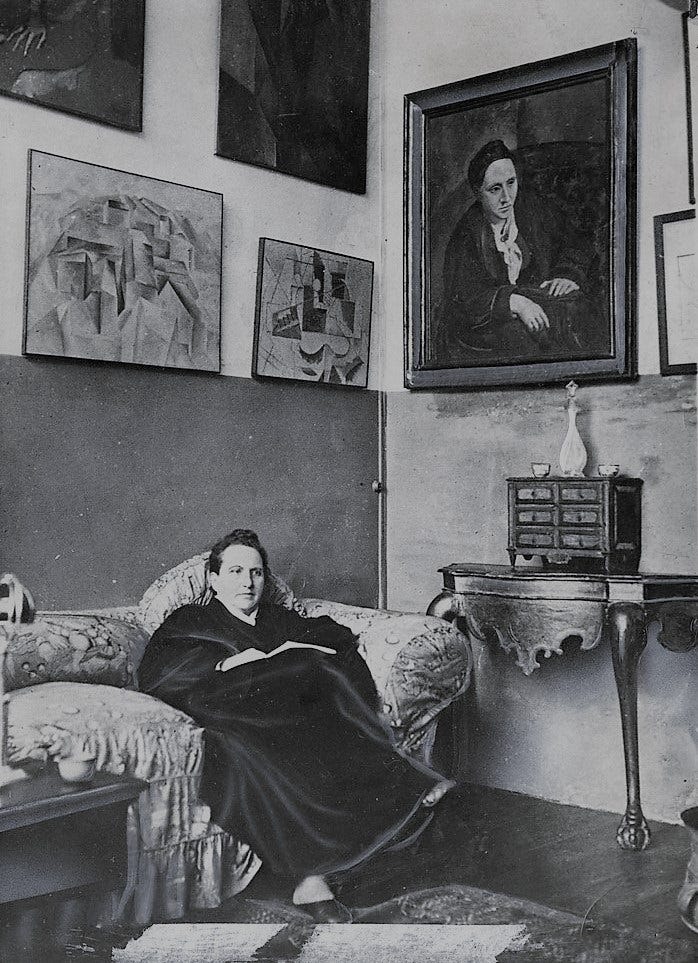
Picasso painted Stein. Stein and Hemingway had a falling out. Matisse was a friend. Ezra Pound was a guest. She knew William Carlos Williams, F. Scott Fitzgerald, and James Joyce. The walls showcased art by Cézanne, Matisse, Picasso, Renoir, Manet, Gauguin, Toulouse-Lautrec, and more.
While most of the people who frequented the salon are names you probably know, how many other writers and artists went unknown?
We can't ever really read or see or admire or include or listen to everything and everyone. There is always a level of pick and choose, and clusters form here and there, clusters based on styles or locations or money and means, or any number of variables around which people gather, living enactments of Venn diagrams.
We are constantly forming small tables, small groups. It is inevitable. Only with small tables can we begin to manage the overwhelm. But small tables maybe need to be fluid, shifting, open to movement and interaction beyond the circle.
Today, there are little groups everywhere, and countless workshops and classes and challenges, newsletters, books, podcasts, and more. There are not just a handful of names to know in the art world. There are not just a handful of people you can read when it comes to buying books. There are not just a handful of people you can listen to when it comes to podcasts. There are not just a handful of musicians or composers or singers. There are not just a handful of artists. It is a wonderful thing to know that art is everywhere and art is constantly being added to the tapestry of "now."
We can't ever do or see or read or gather or collect it all. Yes, there are limits. Yes, you may have to limit the time you spend scrolling because it is an endless tunnel. There is no bottom to the scroll.
But are there only a few that are worth reading or listening to or viewing or supporting?
I don’t want to be given the message that only a few people are worth reading. I think we are richer by exposure and interaction to many different voices and perspectives and visions.
On Reserve
I'm now on a Gertrude Stein kick. The salon is possibly at odds with what I think in terms of widening circles and exposure, but I'm still fascinated with the salon, with the 80+ sittings for the portrait by Picasso, with the friendships and disputes, with the various descriptions and depictions. I'm as fascinated by who was in the circle as by Virginia Woolf's absence.
I've reserved The Autobiography of Alice B. Toklas to read to satisfy this current interest, specifically the one illustrated by Maira Kalman, a personal favorite. I had it checked out once before and didn't read it. Maybe I will this time. I've read enough to know that the book caused a falling out with many of her friends, so I’m curious.
I noticed when Ann Patchett's new book, Tom Lake, came out, but I didn't stop right then and place a hold. By the time I got around to it, I'm far down the list, but I'm looking forward to a read and/or a listen. The audio recording is by Meryl Streep. (We read These Precious Days in my attempted book club last year, and I really enjoyed it. I liked Dutch House, too, which I listened to with Tom Hanks' narration.)
Pick and Choose
I reacted to something I saw last week, and it's spiraled into a confusing reaction both to history, to the dog-eat-dog nature of the world (even, clearly, the creative world), to the survivalist approach most of us need to take to making a living, and to the endless realities of have and have not cycles when it comes to determining success.
Combine all of that with the endless challenges of simplifying life and being more mindful, being more at peace and more satisfied, being less scattered and overwhelmed, and we end up with a muddy mix. It's hard to make sense of all of these things at one time. We do pick and choose.
What matters most.... what you know or who you know?
Would a virtuoso poet weaving words in the middle of nowhere ever rise to the surface? I know people like to believe it happens, that talent rises despite all odds. Unfortunately, I think history tells us differently.
Success is a business. Success often comes at the expense of others or by stepping on toes or shoulders or turning a blind eye. Success often hinges upon starting at a certain place in a network. "Success" often depends upon convincing others that you are the one, on being loud enough.
And it might depend on making it look like a smaller table is the answer.
I'm still for the big table (big gallery). I'm still full of hope that people can scoot back and expand and widen circles and make room.
I'm not much on dog-eat-dog anything. I'm also not a success. I'm just one of those voices that doesn't go away but also doesn't seem to get anywhere. I don't have many illusions.
Maybe I should have learned to take a hint? But I can't stop.
All I know to do is to say out loud again and again and again that there is beauty in the mix. That the loudest bird or the one with the widest wingspan doesn’t necessarily sing the only song you need to hear.
Panel Practice
I am continuing to split my drawing time between several different kinds of practice. I worked on a small set of panels this week to capture one of two or three things I wanted to record in graphic novel style from a recent walk at the beach. Doing this digitally is much different than working on paper. I am trying new things and learning a lot and also sorting out my voice and line right now in this space. One of the things I experimented with this week was the use of color.
Typically, I work in black and white, but working digital opens things up. I find myself wanting to add some color, but finding my voice in color is often confusing. I have a sense of the palette I'm after. I didn't find it this week. Nothing came out with the right softness once I pulled palettes in place. But I did experiment. I re-colored this several times, evaluating each time how the color felt and where it fell in terms of what I'm after. I still haven't found exactly what I'm looking for, but these experiments were helpful. I think you sometimes have to see things in place, and digital is beautiful for this. It's always interesting to see what color adds or how color changes tone.
Made It?
If you made it all the way, thank you! I really enjoy having you respond to something. It's nice to leave a little thumbprint showing you were here.
If you've read anything by Stein before, comment, "buttons" below. If you thought about duck-duck-goose or musical chairs at any point in this post, comment "playground." If you have a book on hold at the library right now, comment "lighthouse." If none of these fit, comment "blueberry ___" (and fill in your favorite). What if more than one is true? You get to choose! Or write a haiku. Be the captain of your own destiny.
Oh, and by the way, I did make a little fortune teller one-pager for practice last week.
Illustrate Your Week — Week 34
The new prompts for Week 34 have been posted.
Thank you for reading the Illustrated Life substack. Please consider subscribing (for free) to receive the weekly email. Writers need readers, and I am grateful for every reader! Please comment and share with someone else who might enjoy it.
Paid options are available for those who can and want to support the substack, the podcast, and #illustrateyourweek. I am trying to keep things free because I want people who can’t pay to be able to read this newsletter. But there are realities to this project, the work involved, my life, and how much hope I am pinning on this space. Subscriptions not your thing? One-time donations are also appreciated.
(Links to books or tools referenced in posts are Amazon affiliate links that help support these projects.)
The screenshot below from the Metabolic Studio website shows a wonderful recreation of what the Stein's salon may have looked like. This installation is part of Metabolic Studio's IOU series. View the photos and read more.





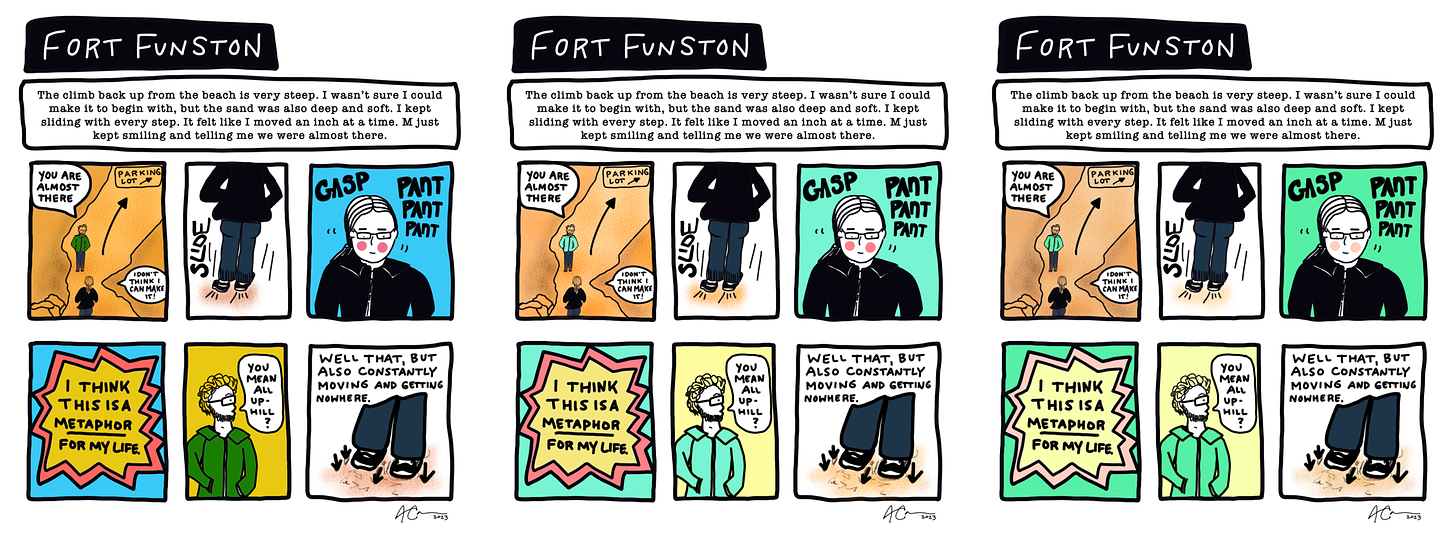
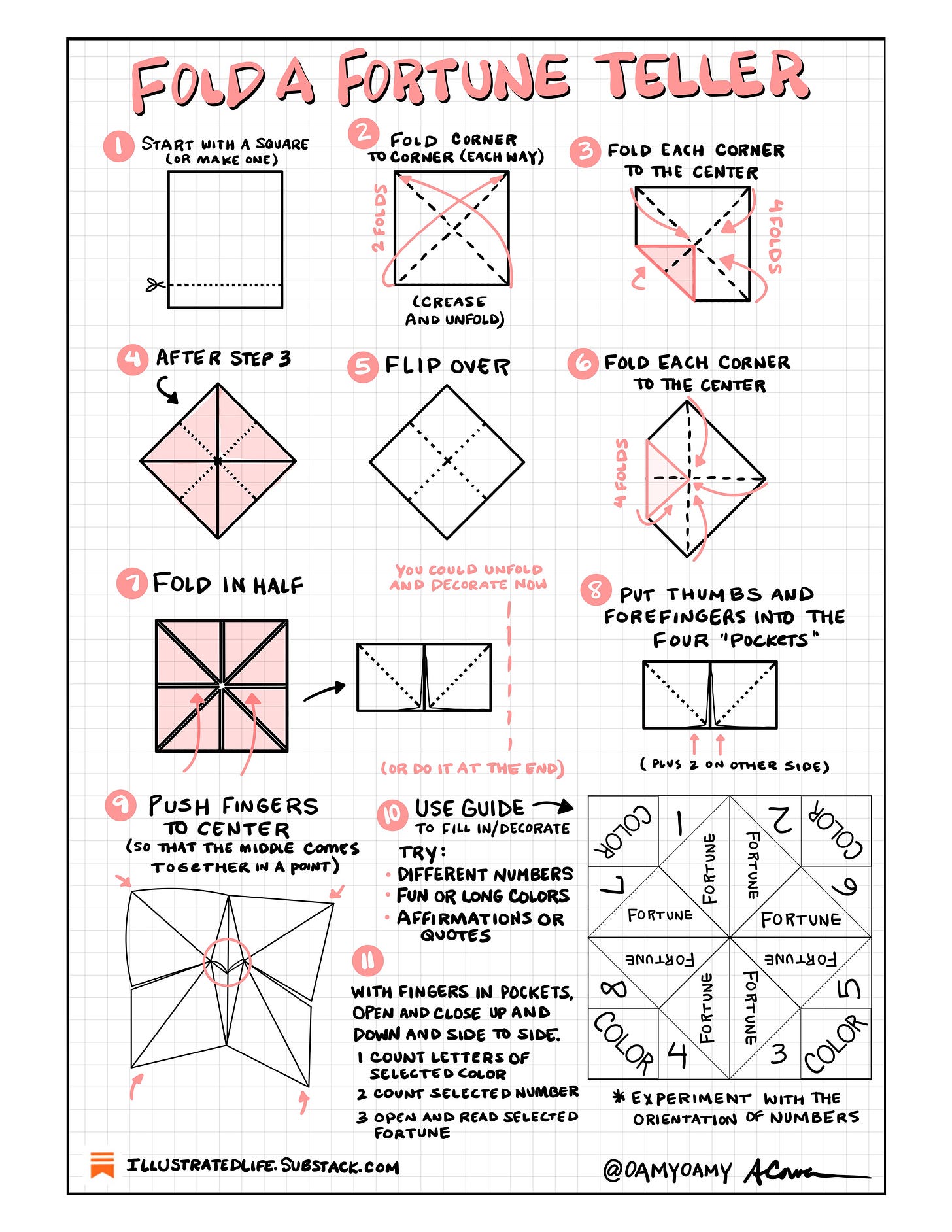
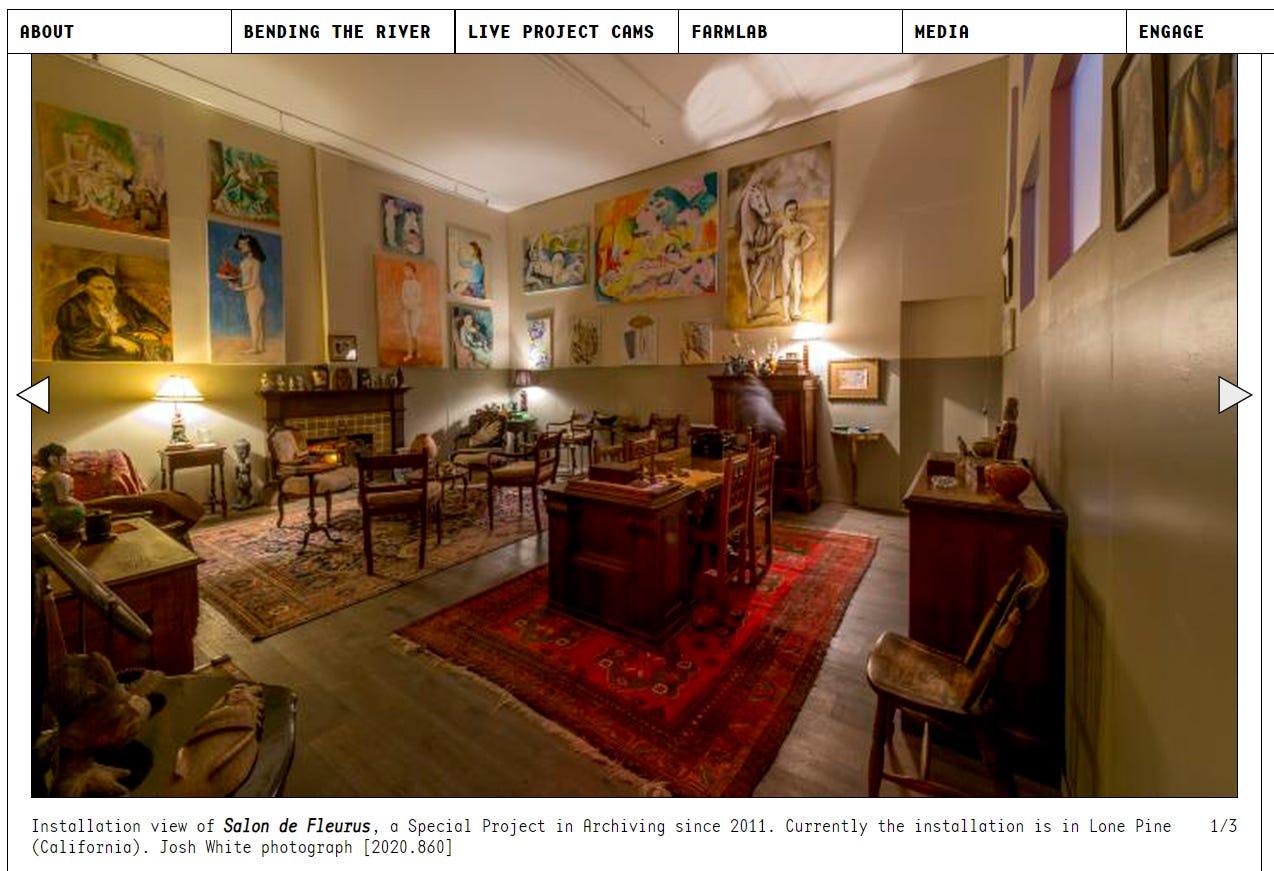
Lighthouse! Or would that be lighthouses? Maybe a small community of revolving lighthouses. In different colors because the topic is always changing.
Go to the lighthouse
Inspire, enrich, explore
Friends, circle around.
As usual, reading your Sunday posts makes me wish it was a conversation over coffee. I always resonate with your words, and think yes, I see you, me too.
When I was in art school, my classmates and I used to frequently joke about the need to photograph or paint each other, so that when we got famous, people would see our connection in our work.